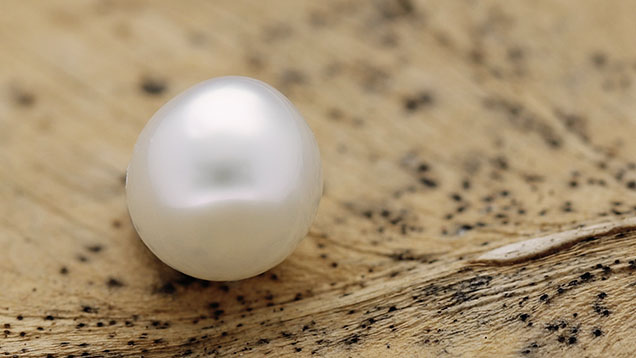Seed Features in an Akoya Keshi Pearl

Recently, GIA’s Mumbai laboratory received a white button-shaped saltwater nacreous pearl weighing 1.90 ct and measuring 6.75 × 6.55 × 6.19 mm for pearl identification (figure 1). When observed under high magnification, the pearl’s surface showed fine fingerprint-like overlapping platelets typical of aragonite. Energy-dispersive X-ray fluorescence revealed a manganese level below the detection limit and a strontium level of 857 ppm, confirming the pearl’s saltwater origin. Under long-wave ultraviolet light, the pearl exhibited a moderate greenish yellow reaction, which is typical for pearls from the Pinctada species.

Real-time X-ray microradiography (RTX) analysis revealed a small oval-shaped core surrounded by a dark gray organic-rich concentric structure displaying an acicular (or radial) pattern (figure 2A). An additional elongated, irregular feature with a linear structure at its center was positioned above the central structure, as indicated by the arrow in figure 2A. The growth characteristic of this additional feature looked similar to the internal structure of surface protuberances that sometimes form on bead cultured pearls. Bead cultured pearls with additional surface protuberances are sometimes referred to as Tokki pearls (M.S. Krzemnicki et al., “Tokki pearls: Additional cultured pearls formed during pearl cultivation: External and internal structures,” 32nd International Gemmological Conference, 2011; https://www.ssef.ch/wp-content/uploads/2018/01/SSEF_Tokki_pearls.pdf). Owing to the existence of an elongated feature, it was questionable whether this was a non-bead cultured (NBC) pearl.
Further examination using X-ray computed microtomography (μ-CT) revealed two light gray seed features in the main concentric growth structure: a larger one near the core in the acicular area and a smaller one close to the outline of the concentric growth structure (figure 2, B and C). Previous studies of saltwater NBC pearls, known as keshi cultured pearls, produced from various Pinctada mollusk species have shown that NBC pearls with organic-rich concentric growth structures sometimes contain seed features made up of a calcium carbonate substance; these seed features appeared light gray in microradiographs. The seed features can be different sizes and shapes, and they are typically found within organic-rich areas in loose concentric ring structures (A. Homkrajae et al., “Internal structures of known Pinctada maxima pearls: Cultured pearls from operated marine mollusks,” Fall 2021 G&G, pp. 186–205).
Conversely, organic-rich concentric structures with acicular patterns are typically associated with calcite formation in some natural pearls. It is therefore unusual to observe seed features in an acicular organic-rich structure. The presence of both seed features and the elongated Tokki-like feature in this pearl indicated an NBC pearl formation, most likely produced from the Pinctada fucata (akoya) oyster based on internal structure and external appearance.
While seed features can be found in natural pearls, they are usually located on the outer concentric rings closer to the pearl’s surface and, in some cases, may contain fine growth arcs (A. Homkrajae et al., “Internal structures of known Pinctada maxima pearls: Natural pearls from wild marine mollusks,” Spring 2021 G&G, pp. 2–21). In addition, they have a different radiopacity compared to their cultured counterparts.
Differentiating between natural and cultured pearls poses a significant challenge, given that pearls are unique products of living organisms. μ-CT has enabled gemologists to provide conclusive results on certain features associated more with NBC pearls that are not visible on RTX images, such as the seed features in this example. Seed features are more commonly observed in cultured pearls originating from Pinctada maxima. This pearl is noteworthy due to the rarity of seed features in akoya keshi pearls and in this case its combination with an acicular structure.



